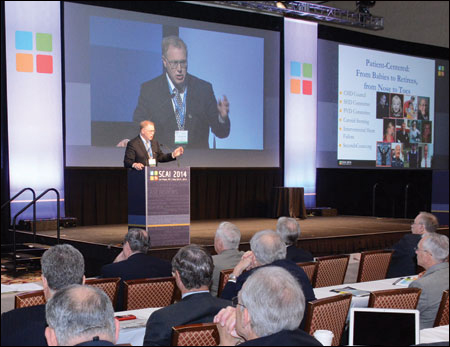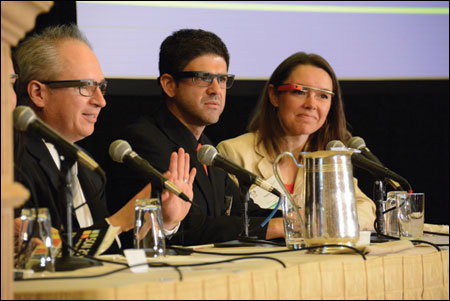The Take Home: SCAI Scientific Sessions
Click Here to Manage Email Alerts

Photos courtesy of SCAI
The annual Society for Cardiovascular Angiography and Interventions Scientific Sessions was held in Las Vegas at the end of May, and featured cutting-edge research, taped cases from around the world, case reviews, interactive workshops and more. At the meeting were John P. Reilly, MD, FSCAI, of Ochsner Medical Center, New Orleans, and Henry Liberman, MD, FSCAI, of Emory Healthcare, Atlanta, who offered Cardiology Today’s Intervention their shared account of the meeting’s highlights.
John P. Reilly, MD, FSCAI; and Henry Liberman, MD, FSCAI
SCAI 2014 was one of the best meetings to date for interventional cardiology. The meeting featured several excellent programs that filled the meeting rooms to capacity.
Training Camp for Cath Lab Directors
The inaugural Cath Lab Leadership Boot Camp, directed by SCAI President Charles Chambers, MD, received enthusiastic reviews. The days of the busiest physician automatically ascending to the role of cath lab director are ending and the skill set that makes one an expert clinician may not guarantee success as a cath lab director. With all the new technology, guidelines and regulations, the complexities of managing a cath lab and its personnel are increasing. Many cath lab directors have been filling their roles without training for the administrative needs of that job.

John P. Reilly

Henry Liberman
This program filled that void. Several important issues were addressed ranging from inventory management and cost containment to conflict resolution and enforcement of guideline and appropriate use criteria (AUC) adherence by the physicians. There is a great deal of pressure on cath lab directors who are tasked with monitoring staff and physician performance so that timely corrective action occurs before problems escalate. Several speakers discussed these difficult issues and recommended best approaches for dealing with problems. Involvement of hospital administration, nursing and physician leadership and legal counsel is essential to ensure optimal performance, guideline adherence and patient protection in a fair and unbiased fashion. Negotiating these minefields without training and support can be very stressful, time consuming and expensive.
Other difficult areas discussed included the introduction of new technology and balancing the financial burden of these new programs against patient benefit, reputation of the institution and physician egos. The ethics of these procedures and ensuring that only appropriate patients are treated can also present major challenges that need to be met. Continuing training, academic and research pursuits are necessary for the benefit of our future patients. We can anticipate that the boot camp will become a fixture in future meetings. Advice and guidance derived here will help individuals in various disciplines successfully negotiate the ever-changing landscape of medicine today.
A Look into Google Glass
On the opening day of the meeting, a highly anticipated session on Google Glass was standing room only. The discussants focused on the potential for this novel technology to facilitate and improve patient care. The discussants agreed that the potential for the device to allow operators to take images of cases in real time could be a big benefit. Combined with the device’s communication capability, consults on difficult cases may become much more helpful. One could capture a picture or video loop of a challenging case and then send it to a partner down the hall or in the office. If the communication is HIPAA compliant, perhaps even across the state to a colleague or mentor. Looking at the image, their advice will likely be much more specific to help with the challenge the operator is facing. They also described potential for Google Glass as a training tool. It would allow the operator to broadcast what he or she was seeing to students and trainees. This would eliminate students and trainees crowding around the operating table to watch the procedure, so that they don’t get in the way of cath lab personnel. So far, the projected image is restricted to where the operator faces, and it can be distracting if there are too many head movements. However, the potential to improve the way we consult with colleagues or educate trainees has not yet been harnessed as the apps required to perform these tasks are not currently available. Although this tempers the enthusiasm somewhat, attendees and speakers alike are excited by the prospects of Google Glass in the cath lab.
The Continuing Need for Cardiologists
Current American College of Cardiology President Patrick T. O’Gara, MD, offered a provocative analysis of the current and future state of the cardiology workforce in his Hildner lecture. Fifteen years ago, the medical education community was focused on creating more primary care and family practice physicians, as there was concern that too many subspecialists were being trained. O’Gara challenged that belief. As our population becomes older and heavier, with an explosion in the rate of type 2 diabetes, the need for CV specialists will increase, not decrease. But graduating cardiology fellows frequently encounter difficulty finding their ideal job. O’Gara pointed out the disparities in our country between urban and rural communities with respect to the number of practicing cardiologists. Although large urban centers may have a glut of cardiologists, other communities will face challenges in access to cardiac care in the next decade. He also highlighted that women, Hispanics and African Americans are underrepresented in cardiology.
Combine these demographics with changing practice models and many practices are currently doing the same work with fewer subspecialists. As the changing economics of health care continue to evolve, practices are functioning with fewer subspecialists. O’Gara anticipates that the greatest need in the next decade will be in training more general cardiologists.
Quality Care, Structural Heart Disease Highlighted
Several sessions were dedicated to structural heart disease, sharing experience in established technologies and introducing new developments. Experienced operators shared their approach — both in case demonstrations and didactic lectures — to difficult cases, emphasizing case selection, procedural techniques and tips to insure procedural success and the minimization of complications. These presentations, with the involvement of expert panel members and the audience, generated vigorous discussion.
In addition to the structural track, the annual meeting has incorporated a dedicated track on providing quality health care for the past few years to parallel tracks in coronary interventions, peripheral interventions and structural heart disease. Multiple sessions focused on various quality initiatives, databases and complex rules and regulations. All of these have become part of our everyday life and we have to adapt and change to prosper in this new environment. SCAI has been instrumental in providing the necessary tools to accomplish this. Focus on quality was a major part of this year’s meeting as it had been for several years. Multiple educational initiatives such as the SCAI-QIT (Quality Improvement Tool) were prominently featured.

SCAI faculty members — from left, Homero Rivas, MD; Christian Assad-Kottner, MD; and Heather Evans, MD — don Google Glasses during a session discussing the technology and its potential applications in the cath lab.
Abstracts Abound
This year’s meeting saw the greatest number of submissions of original research. Abstracts were presented in oral sessions and in a poster session that generated a lot of interaction between meeting attendees and researchers. One of the hallmarks of the SCAI annual meeting is that it provides a venue for communication between the program faculty, researchers and members. Two distinct abstracts demonstrated how the incorporation of the SCAI AUC app improved the performance of the rate of appropriate procedures performed. Several abstracts demonstrated relationships between procedural volume and a number of outcomes, with the highest volume hospitals and cath labs demonstrating shorter lengths of stay and fewer complications. While many regular attendees of the SCAI annual meeting over the years have enjoyed the focus on education, the building buzz around the research presented in the “Best of the Best” session as well as throughout the meeting has pushed the meeting even higher.
Final Word
The combination of research, education and quality assurance has made the annual SCAI meeting essential for all disciplines involved in our specialty both for today and the future.
